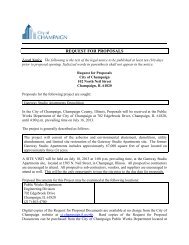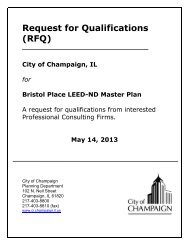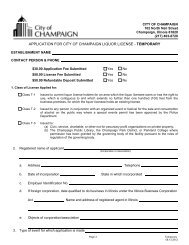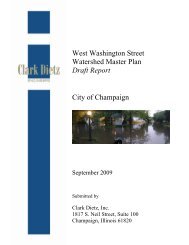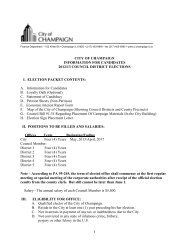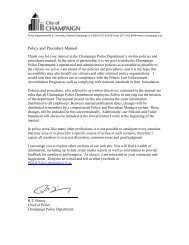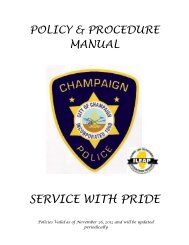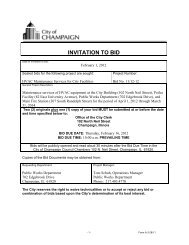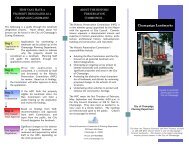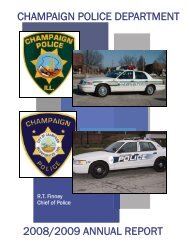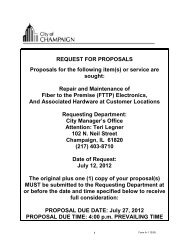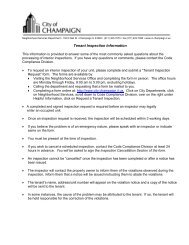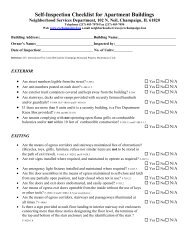2010-2014 Consolidated Plan - City of Champaign
2010-2014 Consolidated Plan - City of Champaign
2010-2014 Consolidated Plan - City of Champaign
You also want an ePaper? Increase the reach of your titles
YUMPU automatically turns print PDFs into web optimized ePapers that Google loves.
monies to provide housing assistance to families connected with the Illinois Department <strong>of</strong> Children andFamily Services. Crisis Nursery <strong>of</strong> <strong>Champaign</strong> County provides shelter for infants and young childrenduring family crises situations, and childcare services for parents during job searches and for workingparents when childcare arrangements are disrupted.Budget Counseling – <strong>Champaign</strong> County Regional <strong>Plan</strong>ning Commission and the University <strong>of</strong> IllinoisCooperative Extension Unit provide one-on-one and group sessions to resolve difficulties with credithistories that might prevent a household or individual from renting an apartment or purchasing a house.TIMES Cente requires all transitional housing program participants to attend a money-management classheld onsite.Goals and Strategies to Address HomelessnessGoal: Provide Support for existing agencies delivering services to homeless individuals and families andencourage the expansion <strong>of</strong> local services to meet community homeless needs.Strategy: Support the existing network <strong>of</strong> local homeless services.• Continue to provide leadership and support <strong>of</strong> Continuum <strong>of</strong> Care.• Provide support to emergency and transitional shelters through <strong>Consolidated</strong> Social ServicePool fund allocations.Strategy: Improve and expand the existing network <strong>of</strong> local homeless services.• Support and encourage local efforts to acquire additional grant funding.• Support accurate and comprehensive data management through the HomelessManagement Information System (HMIS) and annual surveys.• Encourage expansion <strong>of</strong> transitional housing for women and children.• Encourage development <strong>of</strong> emergency shelter services or transitional housing for homelesstwo-parent households with children.• Encourage development <strong>of</strong> transitional living facilities for adults and youth with substanceabuse issues.• Encourage the development <strong>of</strong> a shelter facility to provide emergency services for elderlypersons who are victims <strong>of</strong> domestic violence.Strategy: Regularly review and evaluate the needs <strong>of</strong> the community for homeless andhomeless prevention service, and encourage local agencies to match service provided tocommunity needs.• Encourage and support area agencies to develop services such as Supportive Housing andSafe Havens for targeted populations such as homeless teens, teen parents, families,persons with disabilities, etc.Strategy: Take steps to stabilize households at risk <strong>of</strong> homelessness.• Develop and support rental assistance programs, with and without supportive services forextremely low and very low income persons.• Support programs <strong>of</strong>fering permanent housing solutions for low and extremely low incomehouseholds• Support educational services including financial literacy, homeowner education and debtmanagement.Continuum <strong>of</strong> Care: Institutional StructureThe Urbana-<strong>Champaign</strong> Continuum <strong>of</strong> Care will continue to be the lead organization to address homelessconcerns in the community. The following organizations are members <strong>of</strong> the Continuum <strong>of</strong> Care:38 Needs Assessment: Housing and Homelessness



